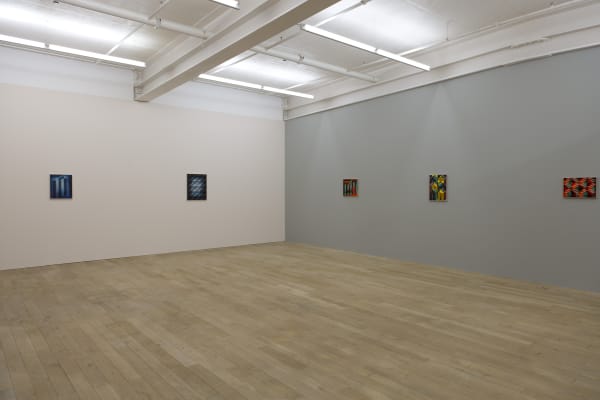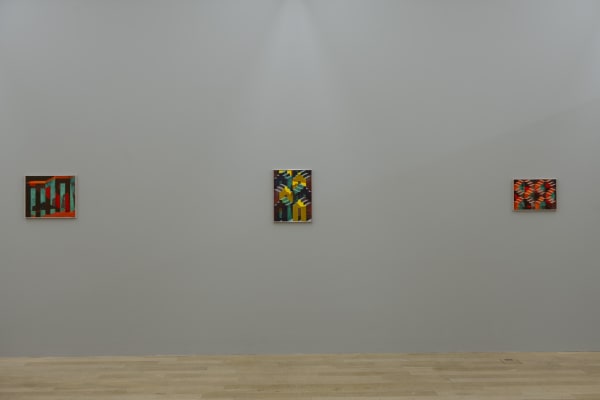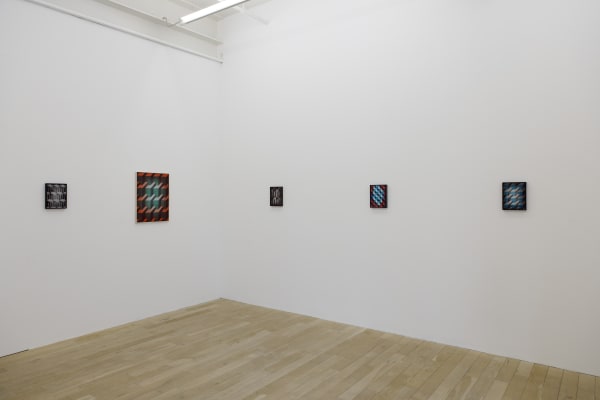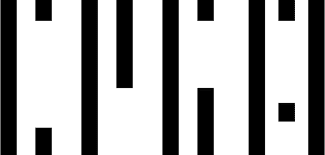Galerie Peter Kilchmann is pleased to be exhibiting works from 2015 by the artist Bernd Ribbeck. The works on show demonstrate an architectonic figuration, whereby Ribbeck leaves out the symmetry which permeated his previous work as a main element and reveals to the viewer a more profane abstraction.
Two series can be distinguished: on the one hand pictures with graphic, repetitive structures on changing monochrome backgrounds produced with acrylic paints and ballpoint pen and on the other, representations of architectonic constructions in which painterly methods and levels are multifariously intertwined. The sizes of the 14 exhibited paintings vary and as in the past, the paintings are on a rigid surface, an MDF board (medium density fibreboard). The coexistence of various techniques produces hybridity in the works and the traces of how the paint has been applied, including being sanded or scratched off, lend the pictures a weatherbeaten appearance and a scratchy, shot, indistinct colouring. Isometric constructions are common to all of Ribbeck’s new works. The concentration of geometrical elements arranged behind and next to each other on a small picture surface produces an apparent depth which lends the picture three dimensionality.
Part of Ribbeck’s approach in the series of pictures on show is a concern with historical positions from art and architectural history. There are echoes of the impossible spatial images of M.C. Escher and Oscar Reutersvärd, representations of architecture from earlier art history such as by Giovanni BattistaPiranesi, an Italian architectural theorist, and paintings of the early Renaissance. The reference to isometric representations of architecture is more clearly recognisable, such as from the episode of postmodern architecture as found with Massimo Scolari, Rem Koolhaas and Oswald Mathias Ungers.
The architectonic figurations are clearly defined through the use of parallel perspectives in their spatial contexts, but are simultaneously irritating because they cancel out the spatial depth scaling of the central perspective. It is thus a matter of the representation of spatial structures and continuities which are not necessarily possible but which are imaginable, along with an idea of virtuality beyond the common association of this term with digital worlds. According to this, “virtuality” means an imaginary form that is not physical but exists in its functionality or effect. “Virtual” is thus not the opposite of “real” - although it is often incorrectly used in this way - but the opposite of “physical”.
This dichotomy between virtual and physical space makes a central theme of architectonic intervention in the exhibition. In the process parallel perspective forms are taken up and transform themselves from an “imagined” into a “real” spatiality. The four sides of the arcade architecture as well as the exhibition space are painted in various colour gradations and bring the painted shadows in the pictures into the real space. The construction is thus scenery and at the same time fulfils the function of separating the exhibition space and creating a spatial situation in which the exhibited works are embedded.
An extract from Italo Calvino’s “Invisible Cities” appears very apt here: “In vain, great-hearted Kublai, shall I attempt to describe Zaira, city of high bastions. I could tell you how many steps make up the streets rising like stairways, and the degree of the arcades’ curves, and what kind of zinc scales cover the roofs; but I already know this would be the same as telling you nothing. The city does not consist of this, but of relationships between the measurements of its space and the events of its past.”
 Bernd RibbeckUntitled, 2015Acrylic, pen on MDF60 x 45 cm (23.6 x 17.7 in.)
Bernd RibbeckUntitled, 2015Acrylic, pen on MDF60 x 45 cm (23.6 x 17.7 in.) Bernd RibbeckUntitled, 2015Acrylic, pen on MDF60 x 45 cm (23.6 x 17.7 in.)
Bernd RibbeckUntitled, 2015Acrylic, pen on MDF60 x 45 cm (23.6 x 17.7 in.) Bernd RibbeckUntitled, 2015Acrylic, pen on MDF60 x 45 cm (23.6 x 17.7 in.)
Bernd RibbeckUntitled, 2015Acrylic, pen on MDF60 x 45 cm (23.6 x 17.7 in.) Bernd RibbeckUntitled, 2015Acrylic, pen on MDF60 x 45 cm (23.6 x 17.7 in.)
Bernd RibbeckUntitled, 2015Acrylic, pen on MDF60 x 45 cm (23.6 x 17.7 in.) Bernd RibbeckUntitled, 2015Acrylic, pen, pigment marker on MDF47.5 x 35 cm (18.7 x 13.8 in.)
Bernd RibbeckUntitled, 2015Acrylic, pen, pigment marker on MDF47.5 x 35 cm (18.7 x 13.8 in.) Bernd RibbeckUntitled, 2015Acrylic, pen on MDF60 x 48 cm (23.6 x 18.9 in.)
Bernd RibbeckUntitled, 2015Acrylic, pen on MDF60 x 48 cm (23.6 x 18.9 in.) Bernd RibbeckUntitled, 2015Acrylic, pen on MDF45 x 36 cm (17.7 x 14.2 in.)
Bernd RibbeckUntitled, 2015Acrylic, pen on MDF45 x 36 cm (17.7 x 14.2 in.) Bernd RibbeckUntitled, 2015Acrylic, pen on MDF25.5 x 18 cm (10.0 x 7.1 in.)
Bernd RibbeckUntitled, 2015Acrylic, pen on MDF25.5 x 18 cm (10.0 x 7.1 in.) Bernd RibbeckUntitled, 2015Acrylic, pen on MDF24 x 18 cm (9.4 x 7.1 in.)
Bernd RibbeckUntitled, 2015Acrylic, pen on MDF24 x 18 cm (9.4 x 7.1 in.) Bernd RibbeckUntitled, 2015Acrylic, pen on MDF24 x 18 cm (9.4 x 7.1 in.)
Bernd RibbeckUntitled, 2015Acrylic, pen on MDF24 x 18 cm (9.4 x 7.1 in.) Bernd RibbeckUntitled, 2015Acrylic, pen on MDF52.5 x 30 cm (20.7 x 11.8 in.)
Bernd RibbeckUntitled, 2015Acrylic, pen on MDF52.5 x 30 cm (20.7 x 11.8 in.) Bernd RibbeckUntitled, 2015Acrylic, pen, pigment marker on MDF30 x 24 cm (11.8 x 9.4 in.)
Bernd RibbeckUntitled, 2015Acrylic, pen, pigment marker on MDF30 x 24 cm (11.8 x 9.4 in.)






















